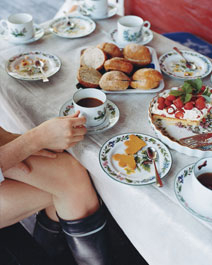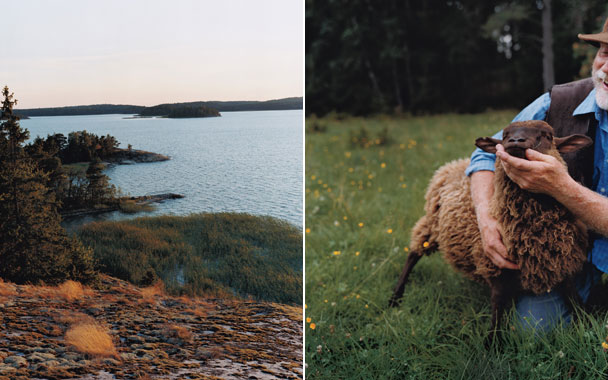Whenever I arrive at Steninge, my mother’s family estate on the southwest coast of Finland, the casual intimacy with nature always startles me at first.
“I heard the nightingale yesterday,” someone will remark, sitting on the lawn in front of my grandparents’ red wooden villa.
“Oh, is he back? I haven’t heard him yet,” someone else will say, glancing over the top of the newspaper.
Back home in my Brooklyn apartment, I deliberately try to keep most of the local wildlife out. My ears are more attuned to the sound of the self-appointed “concierge” of my building, Crazy Howard, throwing bottles at neighborhood teens than they are to warbling birdsong. My sister practically calls Interpol whenever she sees a mouse, and my brother couldn’t pick a bird out of a police lineup. But every summer since my American father and Finnish mother married, more than 30 years ago, and settled down in the States, they (and, eventually, we kids) have been returning to Steninge. It never takes long for Finnish cottage life to rewire our brains. Pretty soon, I’m joining the fray: “Was a chicken singing outside my window last night?”
“Yes, the pheasant was announcing his availability,” my moth-er informs me, as if the bird were extended family.
Steninge exists in complete privacy—a handful of aunts and uncles live in scattered forest cottages connected by footpaths to my grandparents’ villa. We can dart naked from sauna to sea, like blanched potatoes into an ice bath, in the bright evening light. We wear what we call the Finland Collection, beloved tatters from ink-spotted dress shirts to patched-up pants that have a second life at Steninge. We can dress like a lost tribe of boxcar children, and no one’s the wiser.
It wasn’t always like this.
My great-grandfather purchased the estate more than a century ago, having returned to his native Finland after 17 years as a watchmaker and goldsmith in Australia. Some 20 families lived on the farm. The men worked in the fields, growing rye, barley, and oats. The women worked in the manor house or in the 100-cow dairy. My grandfather sold the fields in the 1960s, and now the work that used to require teams of men is accomplished by two or three.
Steninge reflects a broader pattern: In 1950, 47 percent of Finns made their living through farming and forestry (the two have been linked since the 1890s, with forestry supplementing the income of Finland’s relatively small, family-owned farms). Today, the percentage of the population living off agriculture is in the single digits. But if the demographics seem to have shifted—the updated image of the Finn is the sleek, Nokia—toting city dweller—summer sets the clock back.
In a country of only about 5.2 million people, where forests still cover 69 percent of the land, a sizable portion of the population retreats to almost 500,000 summer cottages. Forty percent of the population fishes, and more than half engage in berry picking or mushroom foraging. These statistics come as no surprise to anyone who has traveled the southern countryside and seen everyone from toddlers to grandmothers waving their barbed fishing hooks overhead or, like detectives, combing the undergrowth with their brushes and knives.
Afternoons at one o’clock, the cottages at Steninge empty out and our family converges on the villa. My grandmother sets out the rye rolls and strong coffee that used to constitute a farmer’s field break. Coffee time, when we chat idly and pass around newspapers and cream, provides us with our daily dose of socializing. In a day that begins and ends with suitless dunks in the sea, it’s a good excuse to put on pants.
It’s also an excuse for baking. When my mother was growing up in the shadow of World War II and war reparations to the Soviet Union, only on Sunday might coffee time include a cake or pulla—the sweet, cardamom-flecked bread so beloved here that it should be etched onto the Finnish coat of arms, right between the lion’s jaws. Long after rationing ended, habits of parsimony and home industry have endured. My grandfather, a former judge in the Turku Court of Appeals, collected honey from his own beehives and made wine from his currants and tea from his mint. He still lays out nets for fish and tends to a vegetable garden and an orchard with my grandmother. As children, my mother and her sisters fried doughnuts outside in a kettle of oil in the summer months, and in the winter they molded caramel lollipops in wax-paper cones set in the snow. Nowadays, though, pies and cakes show up frequently at coffee time in the hands of my aunts and cousins, a response to the panic-inducing superabundance of wild blueberries, strawberries, and raspberries lining the roads along the property.
The cult of summer in Finland reaches a particular frenzy at Midsummer, the longest day of the year, which Finns celebrate with a fire marshal’s nightmare of beer and bonfires. My family gathers on a massive granite slab called Karinokka, which slopes into the sea at the end of the property. Much of the southwestern coastline looks like Karinokka: Ancient rock (some of the oldest bedrock in Europe) juts out from the forest in varying formations, from huge cliffs to jagged wedges.
At Midsummer, across the seascape we see the bonfires of our neighbors, with whom we have a vague feeling of competition. Fortunately, my uncle Juha is an engineer who specializes in combustion. My small coterie of relatives ends up standing a long way back, holding very long sticks, roasting hot dogs in what looks like the fallout of a flame-ravaged department store. Atop the rock, we watch the sun set slowly, crankily, over long hours of pinks and purples. It dips below the treetops, then comes right back up again.
Juha is the shaman. He knows everything. I remember once, when I was about five, my parents woke us up in the middle of the night, scooped us into the car, and drove out to the fields, on Juha’s instructions. Standing mop-headed and bleary-eyed in our nightgowns, we saw why: Under a blue dusk, a female moose was grazing in the wheat fields with three of her young. We still look up to Juha like kids. At coffee, my sister and I ask him, “Should we go fishing tonight?” He glances up at the sky, then returns his gaze to his coffee cup. “Tonight is a good night,” he says. He’s never wrong.
We set nets in the bay or in the water around Karinokka. The nets might clip a whole school of perch or bream, or snag a lonely flounder; early in the summer we get wild salmon coming inland to the rivers. We clean and scale the fish, and if we want to get fancy, we hand them to my grandfather. Using the knife that hangs from his belt all summer long, he zips along the fish’s ribs, and within seconds tosses a perfect, opalescent fillet into my grandmother’s hands.
A few times every summer, we scrub the berry stains off our arms and make what feels like a momentous trip into the port city of Turku, about half an hour’s drive from Steninge. My grandmother still presses birthday money into my hand as we head out the door, and I still spend it on candy in the dimly lit turn-of-the-century market hall. Turku is the oldest city in Finland—the Swedes established it as the country’s religious and civic center in the 13th century. (Helsinki only became the capital in 1812, under Russian rule.) Turku’s medieval castle and cathedral still stand, more steadily than the modern-day university students, who teeter, beer in hand, on the bar-boats that line the Aura River.

At the daily outdoor market in the heart of town, piles of fresh berries are displayed next to the produce from surrounding farms, notably the tiny new potatoes that are part of almost every summer dinner. Other vendors offer sugarcoated rolls, dark bread, sausages, and the fish that come from the 20,000-island archipelago that stretches from Turku toward the Åland Islands. The fish vendors have had the entrepreneurial genius to arrange thin slices of their fresh catch, lightly salted and sprinkled with dill, on small paper plates. My mother and I usually start a trip to the market there, standing on the cobblestones and gulping down slivers of raw white fish.
In the past ten years, a new dining scene has emerged along the river, with restaurants emphasizing regional ingredients. Some offer a “Turku Menu” featuring local specialties such as meat from the archipelago’s sheep. Since Finland joined the European Union, in 1995, the country’s restaurants have shown a heightened enthusiasm for foreign foods. So on otherwise traditional menus, prosciutto and Manchego cheese will pop up un-expectedly among the herring and the reindeer.
When we need something we can’t yank out of my grandparents’ garden—fishing line, say, or a chocolate bar—we drive to the Karuna kyläkauppa, a village store just down the road from the farm. Kylä means “village,” but when I was younger, I confused kylä with kyllä, which means “Yes, of course!” I thought this wooden shack called itself the Yes, Of Course Store. This made sense to me because it had everything.
“Mustard and beer?”
“Yes, of course!”
“Tar soap and paper?”
“In the back.”
“Spare oar?”
“Behind the wigs.”
We make up excuses to go to the store for the sheer adventure of it. Karuna resembles other small farming towns on the coast and throughout the archipelago. It has a gas station for boats and cars, a pub heavily patronized by a 20-year-old German shepherd, and a post office where the postlady gives haircuts (unless it’s a beauty parlor that mails packages).
I don’t know exactly why my great-grandfather settled in this little town after 17 years on the other side of the world, but I do know that Steninge pulls us back across the ocean, too, every year. And I’m not sure why a watchmaker with no agricultural experience would decide to run a farm. But Steninge did make a farmer of my great-grandfather, and its transformative powers are still intact.
“Did you see?” I remark at coffee time. “The muskrat found a mate.”
“Good,” comes the reponse. “He needed company.”


